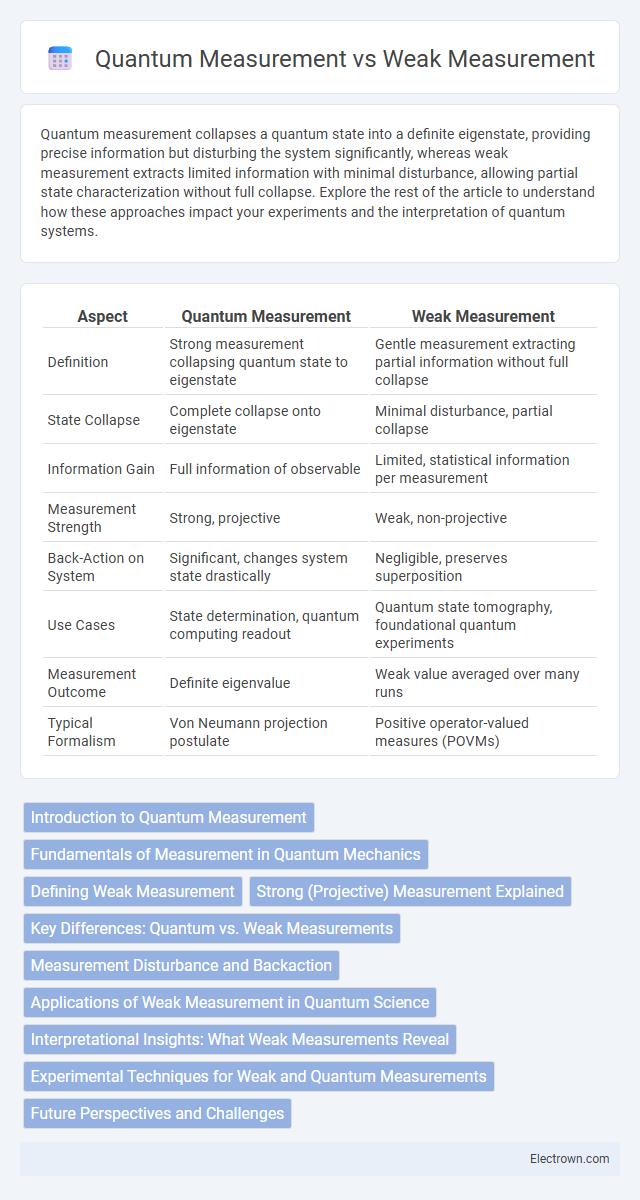Quantum measurement collapses a quantum state into a definite eigenstate, providing precise information but disturbing the system significantly, whereas weak measurement extracts limited information with minimal disturbance, allowing partial state characterization without full collapse. Explore the rest of the article to understand how these approaches impact your experiments and the interpretation of quantum systems.
Table of Comparison
| Aspect | Quantum Measurement | Weak Measurement |
|---|---|---|
| Definition | Strong measurement collapsing quantum state to eigenstate | Gentle measurement extracting partial information without full collapse |
| State Collapse | Complete collapse onto eigenstate | Minimal disturbance, partial collapse |
| Information Gain | Full information of observable | Limited, statistical information per measurement |
| Measurement Strength | Strong, projective | Weak, non-projective |
| Back-Action on System | Significant, changes system state drastically | Negligible, preserves superposition |
| Use Cases | State determination, quantum computing readout | Quantum state tomography, foundational quantum experiments |
| Measurement Outcome | Definite eigenvalue | Weak value averaged over many runs |
| Typical Formalism | Von Neumann projection postulate | Positive operator-valued measures (POVMs) |
Introduction to Quantum Measurement
Quantum measurement traditionally involves a strong interaction causing wavefunction collapse to a definite eigenstate, providing precise, discrete outcomes corresponding to observable eigenvalues. Weak measurement, in contrast, induces only minimal disturbance to the quantum system, allowing extraction of limited information without full collapse and enabling the study of quantum states between standard measurements. This distinction highlights the trade-off between measurement precision and system perturbation in quantum mechanics.
Fundamentals of Measurement in Quantum Mechanics
Quantum measurement collapses a quantum system's wavefunction into an eigenstate of the measured observable, resulting in a definite outcome with a probability given by the Born rule. Weak measurement, by contrast, interacts only minimally with the system, extracting limited information while preserving quantum coherence and enabling the observation of weak values. The fundamental distinction lies in the trade-off between disturbance and information extraction, where quantum measurement induces state collapse and weak measurement allows partial state inference without full collapse.
Defining Weak Measurement
Weak measurement is a quantum measurement technique that minimally disturbs the system, allowing partial information extraction without causing wavefunction collapse. Unlike standard quantum measurement, which yields definite eigenvalues and collapses the wavefunction, weak measurement provides averaged results over many trials, revealing subtle system properties. This method enables the study of quantum systems in a less invasive manner, preserving coherence and enabling insights into quantum trajectories and pre- and post-selected states.
Strong (Projective) Measurement Explained
Strong (projective) measurement in quantum mechanics collapses the wavefunction into an eigenstate of the observed observable, yielding a definite measurement outcome with probability given by the Born rule. This type of measurement significantly disturbs the quantum system, irreversibly altering its state and eliminating superpositions. It contrasts with weak measurement, which minimally perturbs the system and provides partial information without causing full wavefunction collapse.
Key Differences: Quantum vs. Weak Measurements
Quantum measurement involves a strong interaction with a quantum system that causes wavefunction collapse, producing definite eigenvalues and disturbing the system significantly. Weak measurement, by contrast, minimally perturbs the quantum state, obtaining partial information through a weak coupling that allows access to weak values without complete collapse. The key difference lies in the trade-off between measurement precision and system disturbance, where quantum measurements yield sharp outcomes at the cost of state disruption, while weak measurements preserve coherence but provide less definitive data.
Measurement Disturbance and Backaction
Quantum measurement typically causes significant disturbance to the system, collapsing the wavefunction and introducing backaction that alters the system's future evolution. Weak measurement minimizes measurement disturbance by only partially collapsing the wavefunction, allowing extraction of information without fully disrupting the quantum state. Your ability to probe a quantum system with weak measurement enables continuous monitoring with reduced backaction, crucial for applications in quantum control and feedback.
Applications of Weak Measurement in Quantum Science
Weak measurement enables precise probing of quantum systems with minimal disturbance, making it invaluable for exploring delicate quantum states and dynamics. Applications include enhancing quantum error correction, improving parameter estimation in quantum metrology, and enabling direct measurement of wavefunctions without collapsing the quantum state. Your ability to leverage weak measurement techniques opens new pathways in quantum computing, communication, and foundational quantum science research.
Interpretational Insights: What Weak Measurements Reveal
Weak measurements offer unique interpretational insights into quantum systems by allowing observation of a quantum state without causing wavefunction collapse, unlike traditional quantum measurement. They reveal subtle quantum properties, such as the average trajectories of particles and contextual values, providing a nuanced understanding of phenomena like superposition and entanglement. You can use weak measurements to explore hidden quantum correlations and obtain information on the quantum system's underlying reality without significantly disturbing it.
Experimental Techniques for Weak and Quantum Measurements
Quantum measurement techniques typically involve projective measurements that collapse the system's wavefunction, yielding definitive eigenvalues, while weak measurement employs gentle interactions to extract partial information without disrupting the system's coherent state. Experimental setups for weak measurements often use interferometers, weak coupling schemes, and post-selection methods to amplify and detect subtle quantum properties without full state collapse. Your ability to analyze quantum systems with minimal disturbance relies on precision control of interaction strength and advanced photon or superconducting qubit detection technologies.
Future Perspectives and Challenges
Quantum measurement techniques are evolving to enable more precise manipulation and observation of quantum states with minimal disturbance, which is crucial for advancing quantum computing and communication. Weak measurement offers the potential to extract information without collapsing the wavefunction entirely, presenting opportunities to probe delicate quantum systems while preserving coherence. Your ability to harness these methods will depend on overcoming challenges such as reducing noise, improving measurement fidelity, and integrating scalable architectures for practical quantum technologies.
quantum measurement vs weak measurement Infographic

 electrown.com
electrown.com